Tempest Tech-Tip
Alaska Cold Starts

Have you ever wondered if starting an engine in extremely cold temperatures can damage an oil filter?
Background
What really happens in an oil filter during a cold start? First, by cold start, we’re talking about starting an engine in temperatures below about 20 degrees F. In places where it gets colder than a Montana well digger’s butt, many aircraft mechanics have seen oil filters burst by cold starts. But, why does it happen? What’s involved? And what can operators do to prevent it?
Why?
Extremely cold, thick oil is hard to push through the tiny pores in oil filter media. Think of trying to push ice cream through tee-shirt cloth. It will go, but it goes slowly. Compare that with how water goes through the same cloth. There’s a mind’s eye view of what happens in an oil filter when the oil is really cold.
Being driven by the engine, the engine’s oil pump has nearly unlimited power. So, even if there’s high resistance to flow at the filter, the engine pump keeps on delivering oil. The engine’s oil pressure relief valve will open and try to keep oil pressure controlled but, that valve’s bleed-off capacity is finite, and with cold thick oil its capacity can be exceeded if engine rpm goes high. If that happens, oil pressure will soar.
Pressure in a hydraulic system is the result of downstream flow restriction. That’s true generally and true for oil filters. If oil can’t get through the filter as fast as it’s coming in, upstream pressure rises while on the downstream side of the media pressure falls. This differential pressure is called “Delta P”. When Delta P becomes high enough (generally well over 125 psi), either the filter’s element will be crushed, see Figures 1 and 2, (next page) or the filter case seam will burst (generally over 600 psi) see Figure 3 (next page).
When the element crushes the center tube typically collapses, compromising the seal between the element and the base plate and relieving the high Delta P. However, after the element is crushed, you’ll have little or no oil filtration. You won’t find the crushed element until the next oil change, as oil pressure will appear normal on the engine oil pressure gauge.
Crushed elements and burst filter cases are not filter failures and shouldn’t be thought of as such. They are indicators of an underlying problem. The filters are the victims, not the perpetrators of these events.
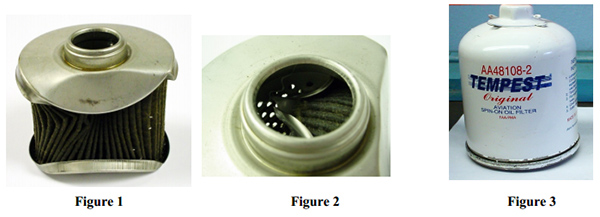
What’s involved?
Typically, with spin-on filters and hot oil, Delta P will be one or two psi. For example, there might be 60 psi upstream of the media and 58 downstream of the media. Thus, only 2 psi is trying to crush the element. However, during a cold start with excessive rpm, Delta P can reach several hundred psi. That’s what crushes the element or bursts the case seam.
A by-pass valve in the oil system helps protect against damage from excessive Delta P. Sometimes the valve is in the filter, typical of most Continental engine filters and sometimes it’s in the engine’s accessory case, typical of Lycoming engines. Generally, the by-pass valve opens between 12 and 15 psi, Delta P. However, like the engine’s main oil pressure valve, the by-pass valve has a finite capacity and, if the engine rpm is allowed to surge before the oil is warm, its capacity can be exceeded and Delta P will rise.
Figure 4 shows a by-pass valve in the upper element cap of a Continental type filter. When oil pressure on the upstream side of the cap becomes excessive (oil coming up from the bottom in the Figure) the valve opens and allows the oil to bypass the media. It flows through the valve and down through the filter’s center tube directly to the engine. An engine mounted by-pass valve worksthe same way, that is to say, it allows the oil to go around the media and straight to the engine.
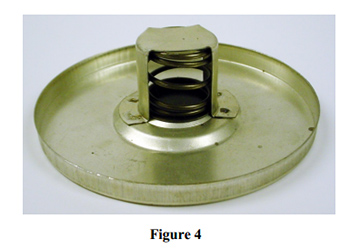
There is a misconception that the element guide/spring, see Figure 5, is part of a pressure relief system in which the element moves upward away from the base plate to relieve Delta P. That’s an erroneous belief. The element guide/spring, whether coil or leaf, just keeps the element in place against the base plate seal.
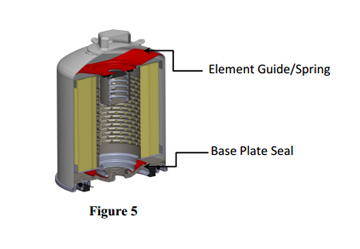
The element is always pushed toward the base plate by the element guide spring and, when the engine is running, by hydraulic force in the filter. To understand why the hydraulic force does this, consider unequal pressures (forces) on opposite sides of a piston. The piston will tend to move away from the higher pressure. That’s an immutable law of Figure 4 Figure 5 Element Guide/Spring Base Plate Sealhydraulics. In a filter full of pressurized oil at no or low flow, all the internal parts are completely surrounded by oil at equal pressure. The sum of those forces is zero(1). They will not tend to move the parts from one location to another inside the filter. However, with high Delta P the forces pressing on some of the parts, namely the element caps, are unequal and, thus, the sum of forces is not zero. The unequal forces will tend to move the element assembly towards the base plate, not away from it.
Consider a Delta P of 100 psi. Oil pushes down on the top and up on the bottom element caps, see Figure 6. Since pressure multiplied by area equals force, if the cap areas are different the forces will be different when subjected to the same pressure. While both caps are about 3 inches in diameter, the bottom cap has a large central hole in it that reduces its surface area. Thus (in this example), the top cap’s down force is about 700 psi, while the bottom cap’s up force is only about 575 psi. That’s a 125 pound force in the down direction – toward the base plate. Forget the stories about the element guide/springs being part of a pressure relief system, they’re not. The higher the pressure becomes in the filter, the harder the hydraulic force pushes the element against the base plate seal.
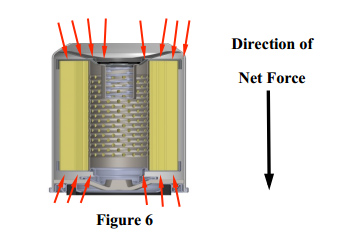
If a filter bursts during a cold start it will likely be obvious because of the attendant oil leak. But, during a cold start when rpm gets high, the filter can also be damaged without bursting, thus causing hidden damage. Always inspect the filter after a cold start during which rpm surges even for a moment. Remove the filter and look inside it. If the tube is crushed, likely you’ll be able to see it. You can use a bent piece of wire to feel the center tube’s shape at the end nearest the base plate where you can’t see it. If it isn’t round, scrap the filter. Look at the top of the filter case on the left in Figure 7. Note its highly domed top compared to the undamaged filter on the right. Such domes typically form at pressures starting about 400 psi. The domes get progressively more pronounced as the pressure goes higher. The filter’s case seam will burst if the pressure goes high enough. If you see a domed filter, that’s proof positive of over-pressurization.
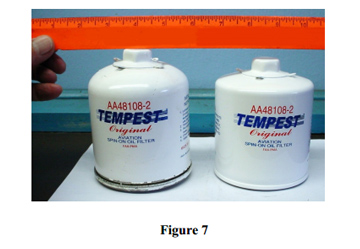
Cold starts aren’t the only thing that can burst a filter. Recently a customer reported that three filters burst, one after another, on his newly overhauled engine. The domed cases proved that the oil pressure was too high. The oil pressure relief valve in the engine was screwed all the way in! He reported that the engine oil pressure gauge showed about 100 psi with cold oil and about 50 psi with hot oil. Likely, the oil pressure gauge had been damaged by the first high pressure event and read low afterwards, but the domed/burst filters didn’t lie.
What can be done to avoid cold start damage?
At normal temperatures, it’s advisable to keep engine rpm low until the engine oil temperature gets into the green on the gauge. In extremely cold temperatures, it’s absolutely imperative to do so!
Bursting a filter or crushing the element needs a combination of cold oil and excessive rpm. What’s excessive? Anything above the minimum at which you can keep the engine running and certainly anything above 800 rpm until the oil begins to warm. The combination of momentarily high oil pump output (high rpm), thick oil, and high restriction in the filter (even for an instant) sends the internal pressure in the filter skyrocketing.
Just because you don’t see excessive oil pressure on the oil pressure gauge in the cockpit doesn’t mean momentary high rpm didn’t do its damage. In very cold weather, oil in the long thin tube to the gauge is nearly frozen. It may take several minutes for the gauge to catch up to what is happening in the engine oil system on a real time basis. While the gauge may not reflect a momentary high oil pressure event, over-pressurization damage will have been done never-the-less.
Obviously, keeping the airplane in a warm hanger is one answer. Engine oil heaters work too. But, remember, the oil filter is sticking out the back of the engine in the free air, so if it’s not warmed by the heater, the oil in it could still be frozen nearly solid. Even with engine block or oil heaters, start the engine and keep rpm as low as possible until the oil begins to warm and circulate.
If rpm does run away, check the filter. Look for a domed top, cracks in the filter’s paint around the installation nut, and/or evidence of oil seeping at the case seam. Check your oil cooler too. It’s a thin sheet metal affair and subject to overpressurization damage. Filter’s that burst because of over-pressurization are not defective anymore than a 600X6 light aircraft tire being burst by putting 500 psi of air in it is defective. If a filter bursts or is deformed, there’s a reason why. The reason needs to be found and corrected, either through maintenance, or by training the operators in how to start the engine in very cold conditions.
Call Tempest® if we can be of help. Share your experiences with us. We learn from you, and what we learn helps us help others. If you have a problem with a Tempest® product, or even think you do, call us. We’ll address it. No hassles. That’s our policy.
Additional Information
For additional information on this Tempest Tech Tip and Tempest products, please go to www.tempestplus.comor call (800) 822-3200.